by Terry Conway
Buying a racehorse has always been a risky business. Along with wine, art and gold, Thoroughbreds have long been the luxury investment of choice for the well-heeled. Keeping them healthy and happy is a quite another thing.
Enter Bruce Jackson.
Nearly seven years ago Jackson, a former trainer– along with his wife Amy, a former jockey– opened the doors to his Fair Hill Equine Therapy Center located on the grounds of the Fair Hill Training Center that straddles the Maryland-Pennsylvania border. It is set within the 6,000-acre natural resource management area that offers a dramatic shift from the bustle of a racetrack.
Behind the Equine Therapy Center is a vivid flower garden of rose bushes and impatiens, which is circled by a large outdoor walking ring. Inside, the barn is bright with plenty of airflow, 50 stalls and an expansive shedrow. There are round pens for lazing about, turnout paddocks to zip across, rolling hills and wooded walking trails to amble along. Still, the facility’s calling cards are the state-of-the-art therapeutic options: a hyperbaric chamber, water treadmill, cold saltwater spa and a whole body vibration plate therapy that was adapted from human sports medicine conditioning and rehabilitation.
Visitors will also find acres and acres of grass — as well as some famous horses.
Kentucky Derby winner Orb has been enjoying his share of clover over the past two months. The handsome bay colt turned up at Jackson’s facility the day after finishing third in the Belmont Stakes. After a grueling Triple Crown campaign, Hall of Fame trainer Shug McGaughey and the colt’s owners, Stuart Janney III and Phipps Stable, decided the Malibu Moon colt needed some good, old fashioned R&R.
“I sent Orb there for two weeks but when I went down to see him he was doing so well. Bruce and I talked and we decided to leave him there,” McGaughey recounted. “I’m thoroughly impressed by Bruce’s whole operation and his ideas on therapy. He guided me through it all and shared with me ideas on the best way for my horses to succeed. I’ve come down three times. You can tell Orb is a happy horse. Every time I go see him, I’m more pleased.”
Orb has received salt water spa treatments on his legs and sessions in the hyperbaric chamber. The basic function of the chamber is to provide the horse with 100 percent oxygen to breathe while in a pressurized chamber. The greater amount of oxygen is dissolved in the blood plasma to treat diseased and injured areas.
Early on Orb’s routine worked like this: in the morning a two-hour grazing session with Fair Hill horseman Mike Call, time in the round pen playing with his jolly ball, lunch, a nap, a session in the hyperbaric chamber, more grazing and then dinner.
More recently he’s been getting steady breezes by his exercise rider Jen Patterson as preparation for the $1 million, Grade 1 Travers Stakes on Aug. 24. Orb has won four races this year, earning more than $2.4 million in 2013.
[pullquote]I’ve seen a big change in Orb. He’s out of his stall five hours a day, nibbling grass, checking out the country atmosphere. His demeanor, he’s so much more relaxed,” said Orb’s exercise rider, Jen Patterson.[/pullquote]“When he first arrived, he would see a deer out in the field and the two would have a stare-down,” Jackson said with a laugh. “He enjoys the country atmosphere, and he’s been thriving here.”
Indeed. On recent visit, Orb’s eyes were bright, his muscles bulged and his dark bay coat glistened. He seems every bit a happy horse.
McGaughey’s original plan was to bring Orb to Saratoga in early August to continue preparations for the Travers. The trainer reconsidered after receiving reports that Orb is thriving under the care of exercise rider Patterson. Instead, McGaughey left the horse at Fair Hill until this past Sunday.
“Jen’s the one asking me, ‘Leave him here for another week, let me work him there one more time without having to change tracks,’” remarked McGaughey. “Working with Bruce, she’s done a terrific job down there. This all fell in place for me. Jen’s family is nearby, so she could stay down there. Jen is a huge part of my operation.”
Patterson grew up in nearby Wilmington, Del. and worked at Fair Hill as an exercise rider and around the barn for steeplechase trainer Ricky Hendriks for five years. After McGaughey visited Fair Hill the trainer elected to ship some of his most talented horses there including Imaging, Hungry Island, Boisterous, Hymn Book, Reload, Puzzling and a nice two-year old. Patterson, as an assistant trainer, has been overseeing them all.
“All of our horses have all done well here,” Patterson related. “There is such an easy-going feeling at Fair Hill. I’ve seen a big change in Orb. He’s out of his stall five hours a day, nibbling grass, checking out the country atmosphere. His demeanor, he’s so much more relaxed. These animals aren’t meant to be in a city. It’s literally a breath of fresh air for them.”
At the Jacksons’ facility business is brisk. The 30 employees are in constant motion, guiding horses from their stall to various treatments or outside to graze or to be turned loose in the paddocks. Inside, on the walls of the front barn that houses the Aqua Pacer are brass name plates of more than 150 horses that have won stakes races after their rehabilitation at Fair Hill.
Each part of the sprawling equine therapy center plays a specific role in a horse’s recovery and fitness training. Sixty percent of the patients are receiving physical therapy for injuries, while the balance are equine post-operative patients. The cold saltwater spa is one of the facility’s most popular modalities. It is used daily to treat a variety of equine injuries, including tendon sprains, ligament issues, bruised shins, foot growth in the early stages of laminitis, and for healing nasty cuts and abrasions.
“Immersing the horses’ legs in seawater is extremely effective in both healing and preventing injury,” said Jackson, who has cropped gray hair and an easy-going manner. He grew up on his parents’ sport horse farm in West Sussex, England.
[pullquote]I’m an old racetrack guy, so it was all new to me. I never thought about shipping my horses to Fair Hill. But I get it. It’s been a huge change in attitude for me,” said trainer Shug McGaughey.[/pullquote]“It’s something that English horsemen have done forever. As a youngster I used to walk our horses down to the sea each day. I can tell you it really kept our horses remarkably fit.”
Snickers, the barn’s Jack Russell, watches as a chestnut colt is led into the spa unit and the doors close all around. Constructed of the same fiberglass material used for building yachts, the equine spa has a non-slip bottom for good footing and rounded edges and recessed handles so the horse won’t snag a hip going in or out.
The saltwater constantly circulates, traveling through a chilling system that maintains a temperature of 35 degrees Fahrenheit. It is roughly 15 degrees colder than ice and water in a bucket, which tends to get warmer as the horse stands in it. The water rises to a level above the knee and hocks but is not allowed to come in contact with the horse’s belly. The temperature of the foot does not impact the horse’s body temperature.
When the spa unit is filled, it contains 520 gallons of water, 150 pounds of Epsom salts, and 100 pounds of sea salt. “The saltwater acts like a poultice on the leg, drawing any heat, inflammation and edema out of the tissues,” Jackson explained. “It’s terrific for soothing, cleansing, and healing any open wounds or sores on the horse. Water aeration also has a massaging effect on the legs. It utilizes a double filtering system and chlorine so that the risk for transferring any infection from one horse to another is is eliminated.”
The horse stands in the spa for 10 minutes. The leg stays cold for another three to four hours, triggering another impressive benefit.
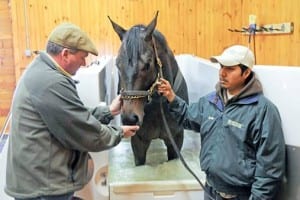
Bruce Jackson, left, works with Orb in the cold water spa. Courtesy of Fair Hill Equine Therapy Center.
“Afterward, the temperature of the leg gradually warms and you get a dilation effect that causes a rush of blood and oxygen to travel through the bloodstream to the lower limb, which traditionally has very poor circulation, and helps heal it,” Jackson related. “That is the biggest benefit.”
Growing up in England Jackson rode dressage horses, show horses and competed in three-day eventing. At age 19 he travelled to Ashwell Stable in Chester County, Pa to work on the training farm of Jonathan Sheppard. Afterward he worked with horses in Germany, Australia and California before returning to England for a stint with Merrick Francis, a son of legendary steeplechase jockey and author Dick Francis.
“I kept feeling this pull back to America so in 1989 I started training here at Fair Hill, but my focus became more and more the therapy facility.”
Horses can either stay at the facility during their treatment or ship in and out as outpatients. All equipment and services are at the disposal of the visiting horse’s veterinarian, who designs the rehabilitation protocol with Jackson and his staff and the Fair Hill vets.
“It’s not a lot of fancy, space-age machines, it’s more about common sense and a gradual increase of their work load over time,” Jackson explains. “It’s about identifying the issue, addressing it correctly and coming up with a program that suits the horse and client’s needs. It’s all about a steady progression, that’s what brings results. I couldn’t do
this without my talented staff. They all take a lot of pride in their jobs. Our aim is get a stronger horse, but that takes time. There are no shortcuts.”
The facility, owned by Jackson and Buddy Jones of Ocala, Fl., has become a valuable adjunct to the racing program of some of the East Coast’s top owners and trainers. Jackson’s top three clients are Fair Hill’s Graham Motion, McGaughey, and Hall of Fame trainer Bill Mott, who takes advantage of the myriad of amenities for his prized runners who may be recovering from surgery, a significant injury, or need to freshen up.
“They look good when they come back,” Mott related. “Some have injuries like bucked shins or are recovering from chips (arthoscopic surgery on leg joints). The horses have been able to maintain a certain level of fitness so we can get started up at the track a little sooner. But the main goal is to get back the best horse you can.”
Orb worked five furlongs in a sizzling 59.20 over the dirt surface at Fair Hill on Aug. 10. McGaughey watched Orb gallop out six furlongs in 1:11, seven-eighths in 1:26, and pull up a mile in 1:41. The move was the sixth for Orb since he arrived at Fair Hill shortly after his third-place finish in the Belmont Stakes on June 8.
“I couldn’t be any happier with what I saw,” McGaughey said. “I had no idea he was going like that until I looked at my watch. He got a little blow out of it – what you’d want. I think this experiment has worked. How he looks, how he seems to be, everything couldn’t be any better.”
Orb was vanned from Fair Hill to Saratoga the next day.
McGaughey is sold on the Fair Hill experience.
“There’s so many amenities, so many options for your horses,” the trainer noted. “Going there allows a horse to be a horse again. I’ve been watching how other horses do after they leave Fair Hill. They’ve run pretty good.
“We’re looking at the logistics of leasing stalls or maybe getting a barn. Our stable needs to have more of a presence than we do. Use it as a getaway to freshen up out horses. I’m an old racetrack guy, so it was all new to me. I never thought about shipping my horses to Fair Hill. But I get it. It’s been a huge change in attitude for me.”
(Featured photo, of Orb at Pimlico, by Laurie Asseo.)

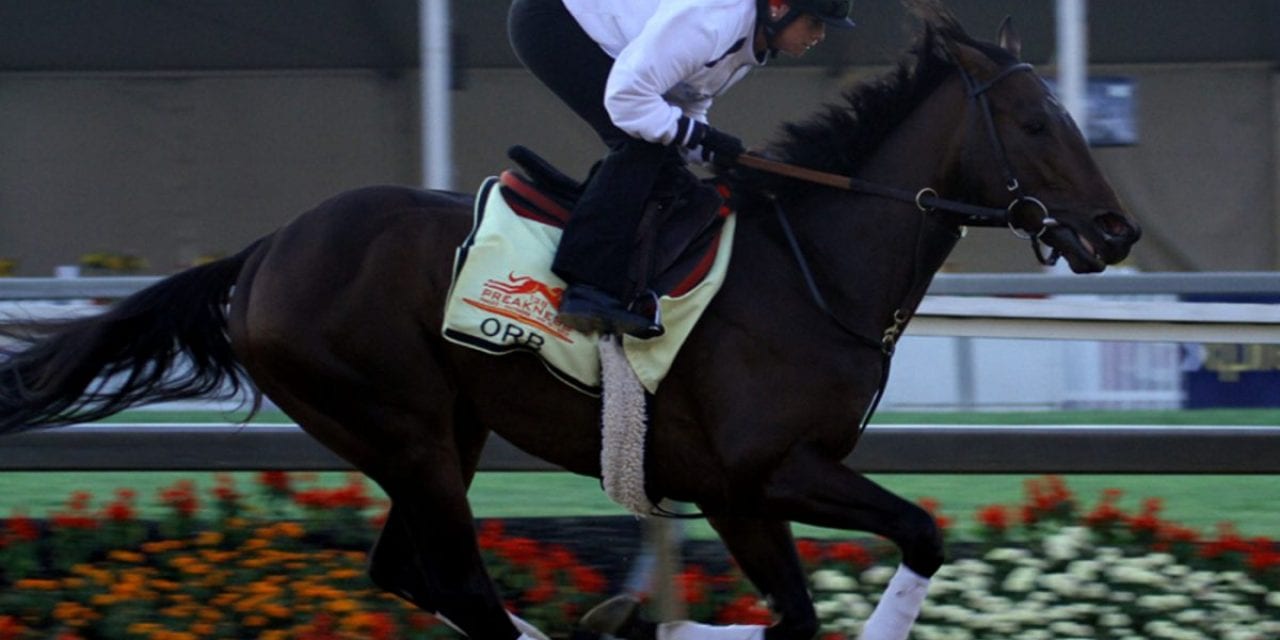
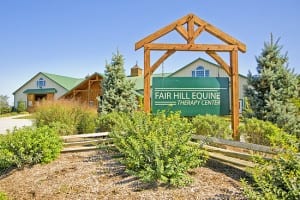
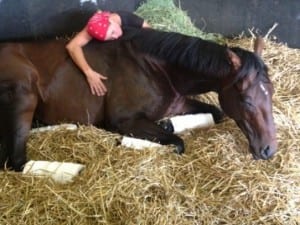
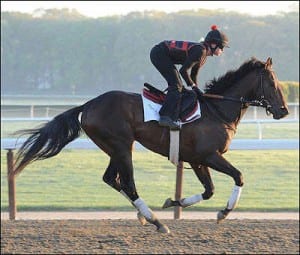






Fair Hill is definitely horse heaven here on earth!